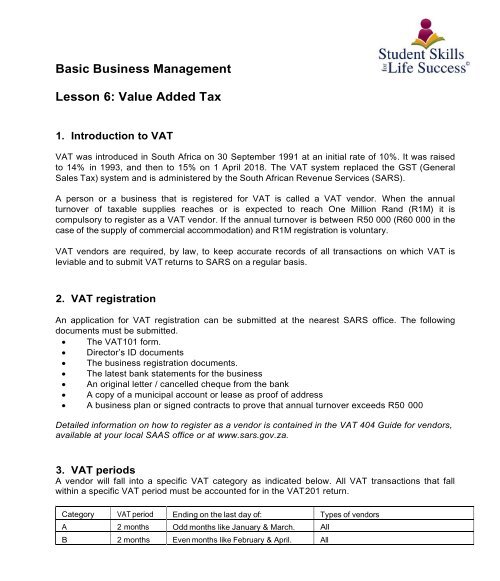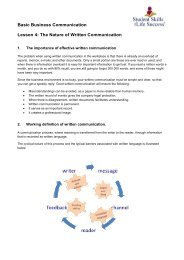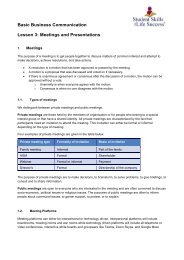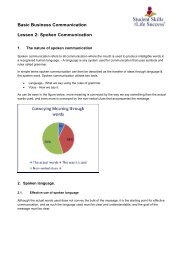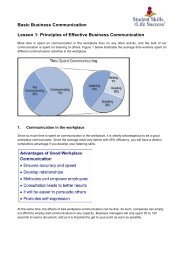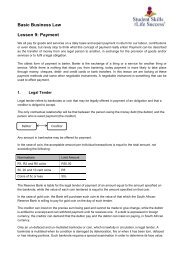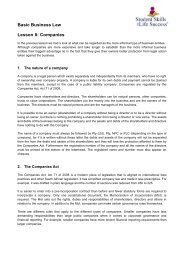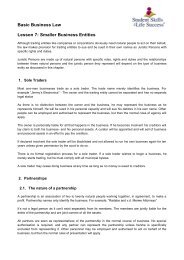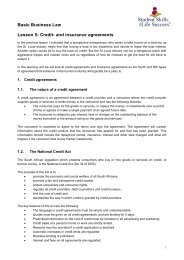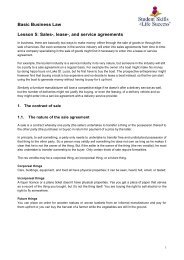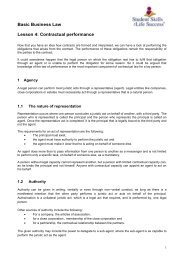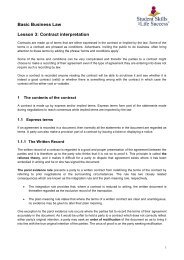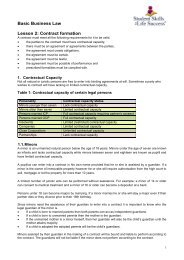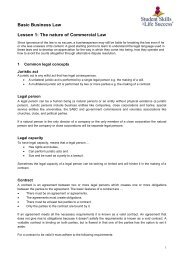Basic Business Management. Lesson 6. Value Added Tax.
This is the sixth lesson of the "Student Skills for Life Success" "Basic Business Management" course. The topics covered in this booklet are: 1. Introduction to VAT 2. VAT registration 3. VAT periods 4. VAT payments 5. VAT categories 6. VAT calculations 7. VAT forms https://youtu.be/X95hNcHfCv0
This is the sixth lesson of the "Student Skills for Life Success" "Basic Business Management" course. The topics covered in this booklet are:
1. Introduction to VAT
2. VAT registration
3. VAT periods
4. VAT payments
5. VAT categories
6. VAT calculations
7. VAT forms
https://youtu.be/X95hNcHfCv0
Create successful ePaper yourself
Turn your PDF publications into a flip-book with our unique Google optimized e-Paper software.
<strong>Basic</strong> <strong>Business</strong> <strong>Management</strong><br />
<strong>Lesson</strong> 6: <strong>Value</strong> <strong>Added</strong> <strong>Tax</strong><br />
1. Introduction to VAT<br />
VAT was introduced in South Africa on 30 September 1991 at an initial rate of 10%. It was raised<br />
to 14% in 1993, and then to 15% on 1 April 2018. The VAT system replaced the GST (General<br />
Sales <strong>Tax</strong>) system and is administered by the South African Revenue Services (SARS).<br />
A person or a business that is registered for VAT is called a VAT vendor. When the annual<br />
turnover of taxable supplies reaches or is expected to reach One Million Rand (R1M) it is<br />
compulsory to register as a VAT vendor. If the annual turnover is between R50 000 (R60 000 in the<br />
case of the supply of commercial accommodation) and R1M registration is voluntary.<br />
VAT vendors are required, by law, to keep accurate records of all transactions on which VAT is<br />
leviable and to submit VAT returns to SARS on a regular basis.<br />
2. VAT registration<br />
An application for VAT registration can be submitted at the nearest SARS office. The following<br />
documents must be submitted.<br />
• The VAT101 form.<br />
• Director’s ID documents<br />
• The business registration documents.<br />
• The latest bank statements for the business<br />
• An original letter / cancelled cheque from the bank<br />
• A copy of a municipal account or lease as proof of address<br />
• A business plan or signed contracts to prove that annual turnover exceeds R50 000<br />
Detailed information on how to register as a vendor is contained in the VAT 404 Guide for vendors,<br />
available at your local SAAS office or at www.sars.gov.za.<br />
3. VAT periods<br />
A vendor will fall into a specific VAT category as indicated below. All VAT transactions that fall<br />
within a specific VAT period must be accounted for in the VAT201 return.<br />
Category VAT period Ending on the last day of: Types of vendors<br />
A 2 months Odd months like January & March. All<br />
B 2 months Even months like February & April. All
C 1 month Each calendar month • Vendors with annual taxable turnover of<br />
more than R30M.<br />
• A and B vendors who wish to apply.<br />
• Vendors who consistently default on<br />
performance of their obligations.<br />
D 6 months February and August Farming enterprises with annual taxable<br />
supplies less than R1.5M.<br />
E 12 months The year of assessment of the vendor A company or trust who receives only<br />
rental Income or admin / management<br />
fees from connected persons who are<br />
registered vendors.<br />
4. Payments vs. the invoice basis<br />
There are two bases upon which a business can register for VAT, namely the payments (cash) or<br />
the invoice basis.<br />
Payments (cash) basis<br />
If a business is registered on a payment basis, the VAT on credit sales and purchases will only be<br />
payable when the money is received or paid and not when the invoices are raised. The payments<br />
basis may only be used by…<br />
• Sole traders and partnerships (all partners must be natural persons), whose turnover does not<br />
exceed R 2.5 million per year.<br />
• Associations not for gain and local authorities may use the payments basis regardless of<br />
turnover.<br />
Vendors who wish to use the payments basis must apply in writing to SAAS to receive permission<br />
to do so. Most businesses in SA are registered on the invoice basis, and that will be assumed in<br />
this course.<br />
Invoice basis<br />
Vendors using the invoice basis will record the Input and Output when an invoice is issued or<br />
received. An advantage of this basis is that Input VAT is recorded as refundable from the time of<br />
invoice, even if the items that was bought are paid for in full over a series of months.
5. VAT Categories.<br />
The VAT201 return summarises the VAT transactions which took place in a<br />
business during the VAT period. It will show the Input VAT claimable and the Output VAT payable.<br />
Only the difference between the two amounts will be claimable or payable. VAT is payable in the<br />
following ways.<br />
• Post a cheque made out to SARS in the reply envelope provided.<br />
• Go to a SARS office and pay over the counter in cash.<br />
• Submit returns and make payments electronically.<br />
For more information you may contact your nearest SARS office or visit their website:<br />
www.sars.gov.za, The (VAT201 return) is the business's VAT return for remittance.<br />
The tables below indicate the VAT categories that are applicable when calculating VAT.<br />
<strong>6.</strong> VAT CALCULATIONS & RETURNS (Example)<br />
P. Holmes is the owner of HL Designs CC trading as HL Designs. The business is a registered VAT<br />
vendor and accounts for VAT on the invoice basis. You have been supplied with the following<br />
information for the September/October 2019 VAT period. Assume a standard VAT rate of 15 %.
All amounts include VAT unless VAT is not applicable. Transactions with nonvendors<br />
are indicated with an asterisk (*). Assume that all vendors have<br />
submitted valid source documents in accordance with the VAT Act (where applicable).<br />
Cheques issued: (INPUT VAT)<br />
Cheque<br />
no.<br />
Particulars Allocation Amount<br />
9 745 The Grocer CC Trading inventory R 41 92<strong>6.</strong>99<br />
9 746 The JAR Office refreshments 2 695.31<br />
9 747 Belkom Telephone 1 138.02<br />
9 748 Blue Cross Donation paid to Blue Cross 1 99<strong>6.</strong>52<br />
9 749 Zorro Municipality<br />
Property assessment rates 1 497.39<br />
Amenities/services 1 697.04<br />
9 750 Max Garage Petrol 2 09<strong>6.</strong>35<br />
9 751 ZAM Stationers Stationery (for business use) 1 717.01<br />
9 752 ZA Traffic department Traffic fines 5 111.10<br />
9 753 Chaser Computers Office computer 109 808.78<br />
9 754 Appliance Land CC Staff room microwave oven 3 993.05<br />
9 755 AGN Couriers Courier fees 1 95<strong>6.</strong>59<br />
9 756 Milk and Honey Suppliers Settlement of creditor 3 034.72<br />
9 757 SARS EMP 201 control 2 635.41<br />
9 758 A. Andrews Plumbing services* 487.25<br />
Debits on the bank statement: (INPUT VAT)<br />
• Debit order for short-term insurance, R 224.14.<br />
• Cheque book fees, R 72<strong>6.</strong>00.<br />
• Interest on overdraft, R 102.32.<br />
Credits on the bank statement: (OUTPUT VAT)<br />
• Receipt no’s 8745 to 9143 for cash sales, R 1 357 635.78.<br />
• Received R 6 334.25 from D. Gripe in settlement of his account (no discount given)
Receipts not included above:(OUTPUT VAT)<br />
• On 4 October 2019, an amount of R 249 565.40, was transferred from<br />
Argentina for goods, which were exported there.<br />
• On 25 October 2019, an original cash invoice was issued for advertising income, R 89 843.54.<br />
• On 13 October 2019, a delivery vehicle was sold for cash, R 215 624.51.<br />
• On 9 October 2019, the business received an insurance pay-out on delivery vehicle damaged in<br />
an accident, R 179 687.09.<br />
Other transactions<br />
• Credit losses written off, R 2 522.98. (INPUT VAT)<br />
• Credit notes issued (on standard-rated goods previously sold), R 1 169.40. (INPUT VAT)<br />
• On 31 October 2019 P. Holmes passed a journal entry for interest on the overdue account of a<br />
debtor,<br />
E. Van Deventer for R 4 991.31. (OUTPUT VAT)<br />
• On 17 September 2019 Zander Catering purchased goods from HL Designs CC for R 65 885.27<br />
on credit. The amount was still outstanding on 25 November 2019. (OUTPUT VAT)<br />
Required:<br />
Calculate the total input and output VAT which P. Holmes can claim or account for on the abovementioned<br />
transactions for September/October 2019 and complete the VAT return.<br />
INPUT VAT<br />
Item Category 201 Return Calculation Amount<br />
Trading inventory STD 15 41 92<strong>6.</strong>99 x 15 / 115 5 468.74<br />
Office refreshments Not Allowed 0<br />
Telephone STD 15 1 138.02 x 15 / 115 148.43<br />
Donation paid to Blue Cross Exempt 0<br />
Property assessment rates Non-Supply 0<br />
Amenities/services STD 15 1 697.04 x 15 / 115 221.35<br />
Petrol Zero 0<br />
Stationery (for business use) STD 1 717.01 x 15 / 115 223.96<br />
Traffic fines Not Allowed 0<br />
Office computer STD 14 109 808.78 x 15 / 115 14 322.88<br />
Staff room microwave oven Not Allowed 0<br />
Courier fees STD 15 1 95<strong>6.</strong>59 x 15 / 115 255.21
Settlement of creditor Non-Supply 0<br />
EMP 201 control Non-Supply 0<br />
Plumbing services* Not Allowed 0<br />
Short-term insurance STD 15 R 224.14 x 15 / 115 29.24<br />
Cheque book fees STD 15 R 72<strong>6.</strong>00 x 15 / 115 94.70<br />
Interest on overdraft Exempt 0<br />
Credit losses written off STD 17 R 2 522.98 x 15 / 115 329.08<br />
Credit notes issued STD 18 R 1 169.40 x 15 / 115 152.53<br />
OUTPUT VAT<br />
21 24<strong>6.</strong>12<br />
Item Category 201 Return Calculation Amount<br />
Cash sales STD 1 R 1 357 635.78 x 15 /<br />
115<br />
Settlement of account Non-Supply 3 R 6 334.25 to 3 0<br />
Exported goods Zero 2A R 249 565.40 to 2A 0<br />
177 082.92<br />
Advertising income STD 1 R 89 843.54 x 15 / 115 11 718.72<br />
Sold delivery vehicle for cash STD 1A R 215 624.51 x 15 / 115 28 124.94<br />
Insurance pay-out STD 12 R 179 687.09 x 15 / 115 23 467.45<br />
Interest on the overdue account Exempt 3 R 4 991.31 to 3 0<br />
Credit sales STD 1 R 65 885.27 x 15 / 115 8 593.73<br />
248 987.76
7. Completing a VAT 201 form<br />
The table below indicates how the VAT 201 form must be completed.<br />
An example of a real VAT201 form is given below.


